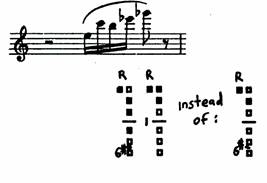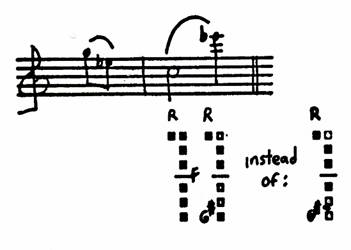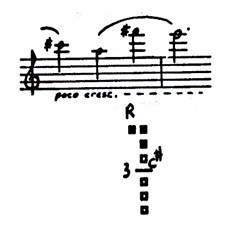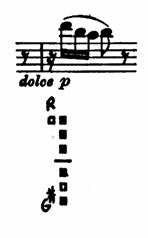| The Clarinet of the Twenty-First Century - E. Michael Richards |
CHAPTER 2 - Single Sounds
Alternate Fingerings
Different timbres of the same pitch on the clarinet are most conveniently achieved through alternate fingerings; embouchure manipulation alone will not work, since it will also affect pitch. However, altering timbre is not the only purpose of alternate fingerings. The artistic clarinetist of the late twentieth century employs different fingerings from standard fingerings in certain musical contexts, throughout the standard orchestral, chamber music, and solo repertoire. 6 These contexts may require a slightly higher or lower pitch for reasons of intonation, a technically simpler fingering for a smoother legato, a less resistant fingering for an easier entrance at a soft dynamic level, or a more desirable tone color for better blend or portrayal of a particular musical character. For example, if one employs the standard G-flat fingering in the following passage (Example #3) found in the first movement of the Sonata by Francis Poulenc, the result will be a low G-flat. The suggested alternate, which is generally a high fingering, will be better in tune at this loud dynamic level (also brighter and thicker/stronger).
Example #3 (click on music to hear mp3)
The production of a smoother legato in the first movement of the F Minor Sonata , Op. 120 No. 1 by Johannes Brahms is facilitated with the alternate E-flat diagramed in Example #4. Contrary finger motion is completely avoided, as is the slide that would be required with the use of the standard E-flat. 7
Example #4 (click on music to hear mp3)
A smoother legato may be attained by the utilization of an alternate F-sharp in the following example ( Concerto - Aaron Copland) for a different reason; an acoustical reason. The A and F-sharp are both partials from the same fundamental (D3).
Example #5 (click on music to hear mp3)
An alternate fingering for D is essential to assist the clarinetist in the production of a soft entrance in the second movement of the Brahms Trio , Op. 114 (Example #6).
Example #6 (click on music to hear mp3)
In the third movement of the Clarinet Concerto by John Corigliano, the alternate fingering indicated below for altissimo B-flat allows the player to not only match the timbre of the distant off-stage clarinetists, but also is easier to play in tune and to play softly.
Example #7 (click on music to hear mp3)
An excellent study of alternate fingerings in the traditional literature has been written by Thomas Ridenour. 8 Rather than duplicate his research, the following pages will focus on examples for the usage of alternate fingerings in new music, and to offer a chart of altissimo register fingerings that, while not exhaustive, does include a variety of technically simple fingerings for pitches of a wide variety of timbres.
In music of the last twenty-five years, the expansion of timbral resources and sensitivities and of usable pitch nuances has become a primary compositional concern. However, in order to indicate (as a composer) and perform (as a clarinetist) alternate fingerings, one must understand the acoustics of the instrument. All pitches on the clarinet do not lend themselves to alternate fingering possibilities. In general, the pitches which utilize the longest length of tube have the smallest number of options; pitches below B3 and pitches between B4 and G5 have few or no alternate fingerings (Example #8).
Example #8
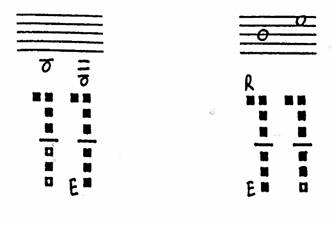
Pitches in the altissimo register have the most alternatives, since they can serve as partials to a number of different fundamentals.
The top half of the chalumeau register and throat register (B3 to A4) offers a variety of "covered" sounding (few strong partials) alternate fingerings. Most of these are cross-fingerings (fingerings that employ open vents, higher on the instrument body than the lowest tone holes that are closed by fingers or keys) which can only be produced at a very soft dynamic level with a minimum of upper partials present. Joji Yuasa and Isao Matsushita exploit these special fingerings in rapid alternations with conventional fingerings of the same pitches (also alternating dynamics: FF to pp) to simulate the sound of rapidly tongued articulations (Example #9). This technique is also conventional for the shakuhachi (on which the performer of traditional solo honkyoku never articulates with the tongue) - a Japanese bamboo flute.
Example #9
Clarinet Solitude - Joji Yuasa (click on measure to hear mp3)
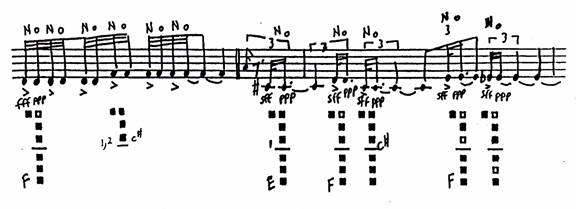
for information on how to see/hear more alternate fingerings, click here
|
||
